
San Andrés de Machaca Municipality
Encyclopedia
San Andrés de Machaca Municipality is the fifth municipal section
of the Ingavi Province
in the La Paz Department
, Bolivia
. Its seat is San Andrés de Machaca.
:
citizens of Aymara descent.
Municipalities of Bolivia
Municipalities in Bolivia are administrative divisions of the entire national territory governed by local elections. Municipalities are the third level of administrative divisions, below departments and provinces. Some of the provinces consist of only one municipality...
of the Ingavi Province
Ingavi Province
Ingavi is a province in the La Paz Department, Bolivia. Its capital is Viacha.- Subdivision :Ingavi Province is divided into seven municipalities which are partly further subdivided into cantons.- Population :...
in the La Paz Department
La Paz Department (Bolivia)
The La Paz Department of Bolivia comprises with a 2001 census population of 2,350,466 inhabitants. It is situated at the western border of Bolivia, sharing Lake Titicaca with Peru. It contains the mighty Cordillera Real that reaches altitudes of . Northeast of the Cordillera Real are the Yungas,...
, Bolivia
Bolivia
Bolivia officially known as Plurinational State of Bolivia , is a landlocked country in central South America. It is the poorest country in South America...
. Its seat is San Andrés de Machaca.
Division
The municipality consists of the following cantonsCantons of Bolivia
||On the level below municipalities, Bolivia is divided into cantons ....
:
- Chuncharcota de Machaca - 400 inhabitants (2001)
- Conchacollo de Machaca - 915 inhabitants
- Laquinamaya - 1.089 inhabitants
- Mauri - 616 inhabitants
- Nazacara - 494 inhabitants
- San Andrés de Machaca - 1.344 inhabitants
- Sombra Pata - 262 inhabitants
- Villa Artasivi de Machaca - 873 inhabitants
- Villa Pusuma Alto de Machaca - 317 inhabitants
The people
The people are predominantly indigenousIndigenous peoples of the Americas
The indigenous peoples of the Americas are the pre-Columbian inhabitants of North and South America, their descendants and other ethnic groups who are identified with those peoples. Indigenous peoples are known in Canada as Aboriginal peoples, and in the United States as Native Americans...
citizens of Aymara descent.
| Ethnic group | % |
|---|---|
| Quechua Quechuas Quechuas is the collective term for several indigenous ethnic groups in South America who speak a Quechua language , belonging to several ethnic groups in South America, especially in Peru, Ecuador, Bolivia, Chile, Colombia and Argentina.The Quechuas of Ecuador call themselves as well as their... |
0.3 |
| Aymara | 96.0 |
| Guaraní, Chiquitos Chiquitos Chiquitos means "little ones" in Spanish. The Spanish Conquistadores chose this name for the people living in the rain savannas of what is now the eastern parts of the Santa Cruz Department in Bolivia, when they found the small doors of the Indian huts in the region.Today, this area is called Gran... , Moxos Moxos people The Moxos, also known as the Mojos, are an indigenous people living around the head-waters of the Madeira River in northern Bolivia, particularly on both banks of the Mamore River. They submitted to Inca domination, but in 1564 gallantly repulsed the Spaniards. A century later, however, the Jesuits... |
0.1 |
| Not indigenous Indigenous peoples of the Americas The indigenous peoples of the Americas are the pre-Columbian inhabitants of North and South America, their descendants and other ethnic groups who are identified with those peoples. Indigenous peoples are known in Canada as Aboriginal peoples, and in the United States as Native Americans... |
3.3 |
| Other indigenous groups | 0.4 |
Places of interest
Some of the tourist attractions of the municipality are:- Afiani lagoon in San Andrés de Machaca Canton
- The chullpaChullpaA chullpa is an ancient Aymara funerary tower originally constructed for a noble person or noble family. The tallest are about 12m high. The tombs at Sillustani are most famous, but chullpas are found across the Altiplano in Peru and Bolivia...
of Kañoma in San Andrés de Machaca Canton - The church of San Andrés de Machaca, built between 1806 and 1836

